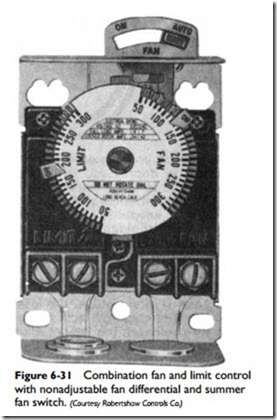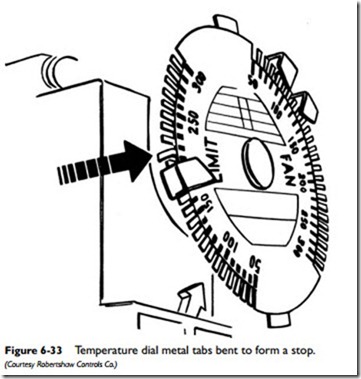Switching Relays
A switching relay is a device used to increase system switching capabilities, to isolate electrical circuits, and to provide electrical interlocks in a heating and cooling system. These devices are especially useful in systems where the heating and cooling equipment have separate supplies.
A typical switching relay contains an integral transformer and a magnetic relay with contacts designed to make or break an electrical circuit. These contacts will be either normally open or normally closed, depending on the design of the relay and its purpose in the heating and/or cooling system.
The 24-volt switching relay illustrated by the wiring diagram in Figure 6-34 is designed to control 115-volt and 24-volt or millivolt circuits. It incorporates a 20 VA 115 V/24 V transformer and a 24 V/60 Hz 0.2-ampere magnetic relay with two normally open contacts. One set of the relay contacts is line voltage rated for the switching of a circulator or other device. The other set of contacts is used for the switching of a self-energized (millivolt) or 24-volt cir- cuit. A terminal board is located on top of the relay cover with screw terminals for connecting a thermostat (terminals T1 and T2) and a gas valve or oil burner control (terminals X1 and X2).
The switching relay illustrated in Figure 6-34 is shown as used in a gas-fired, forced hot-water heating system. In operation, a
thermostat or some other switching accessory (e.g., an aquastat or zone valve) connected to the T1 and T2 terminals starts the circulator and boiler simultaneously by energizing and closing the two pole, normally open relay. When the relay is activated by the thermostat, it closes a circuit from the integral transformer to a magnetic switch, which causes high voltage to be fed to the circulator to start the system pump. At the same time, the second pole of the relay switches 24-volt power to the gas valve or oil burner control, thereby starting the boiler.
A switching relay can also be used as a pilot duty relay to power a contactor and control a crankcase heater for the compressor motor. This type of switching relay has normally closed contacts
that complete an electrical circuit to the heater until the thermostat calls for cooling. When this occurs, the relay switches to break the heater circuit and power the compressor motor circuit.
In installations where a cooling system has been added to a self- energizing (millivolt) heating system, a switching relay may be used to isolate the cooling and heating power supplies (see Figure 6-35). When the room thermostat calls for heat, an isolating relay is used to switch the heating equipment directly.
Heavy-duty switching relays are used for control of high-current loads such as cooling compressors or electric heating where sudden high-current demands are not unusual. The relay is wired to break both sides of the circuit with DPST switching (see Figure 6-36).


